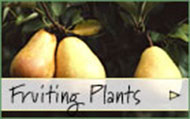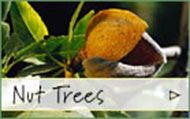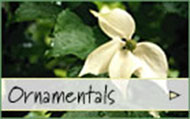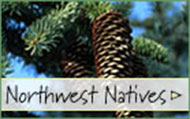NSNDBEA
|
|
 |
| BEAKED HAZEL (Corylus cornuta) |
| Our native hazel. Beaked Hazel trees have small, thick shelled nuts enclosed in a bristly husk. Shy bearing. Late flowering, early ripening, blight immune. Zone 4-8. Plant 2 or more for nuts. CANNOT BE SHIPPED TO OREGON. |
|
|
NSNDBIG
|
|
 |
| BIG LEAF MAPLE (Acer macrophyllum) |
| Massive leaves are up to 15" across, the largest for a maple. Big, fast growing tree, juveniles can grow up to 3 ft. a year and slowing down later in life. Reaching heights of 50-100 ft. Casts dense shade with its 50 ft. spreading canopy. Golden yellow autumn foliage, leaves are very richly nutrient and are prefect for compost use. Provides food and shelter for wildlife year-round. Valued for lumber and fuel. Big Leaf Maples produce a sweet sap for maple syrup but are somewhat limited for production. Long-lived, with some reaching 300 years old. Native from Alaska to California and very common in the Pacific Northwest landscape. Zone 5-8. |
|
|
NSNDBIT
|
|
 |
| BITTER CHERRY (Prunus emarginata) |
| A wild cherry that is a northwest native small to medium sized tree. Pretty flowers and small red fruits in late summer are strictly for the birds. Tolerant of heavy wet sites. Short-lived to 20 or 30 years. Bitter Cherry can be shrubby multi-stemmed to 5 ft. or single trunk tree growing to 50 ft. Zone 4-8. |
|
|
NSNDCHO
|
|
 |
| CHOKE CHERRY (Prunus virginiana) |
| Bears 4-6" long clusters of small white flowers in late spring followed by bunches of reddish-purple tart fruit in August. Chokecherry is primarily used in jams or by wildlife. Tartness is greatly reduced when very ripe, well after fruit has turned dark. Native east of the Cascade mountains from California to British Columbia. |
|
|
NSNDORE
|
|
 |
| OREGON ASH (Fraxinus latifolia) |
| Our west coast native ash tolerates standing water exceptionally well. Grows to 80 ft. tall. Strong, beautiful, elastic wood, great for tool handles and cabinetry. Oregon Ash has a great yellow fall color. Zone 6-8 |
|
|
NSOAORE
|
|
 |
| OREGON WHITE OAK (Quercus garryana) |
| Tough, drought tolerant, Northwest native, dark green leathery leaves, gray bark. Oregon White Oak is a big, majestic spreading shade tree. Zone 6-9. |
|
|
NSNDPACCRA
|
|
 |
| PACIFIC CRABAPPLE (Malus fusca) |
| Able to grow in very wet sites, hence the alternate name Swamp Crabapple. Suitable as a rootstock for apples on sites otherwise too wet. Widely adapted West Coast native from California to Alaska. Pacific Crabapple doesn’t require wet ground. Tiny tart fruits for jelly or for the birds. Zone 5-8. |
|
|
NSNDRDALD
|
|
 |
| RED ALDER (Alnus rubra) |
| Most commercial hardwood tree native to the Pacific Northwest. Has an extremely rapid growth, typically 80 ft. tall in 25 years. Wood makes good indoor furniture and is a clean burning firewood. Red Alder is also a nitrogen fixer; it will grow in infertile ground and make it more fertile. Likes moist ground. Zone 3-8. |
|
|
NSNDVIN
|
|
 |
| VINE MAPLE (Acer circinatum) |
| Native to western North America and very common in the Maritime Northwest as an under story tree that grows below other much taller forest tree and conifers. A very colorful small multi-stemmed shrub or small tree growing to about only 15-20 ft. New growth in the spring has a reddish tinge, followed by small flower clusters. Large, broad leaves are up to 6" wide. Inconspicuous red flowers resemble columbines and provide nectar for beneficial insects, butterflies and bees. Seeds, buds and flowers attract wildlife. Makes a great nesting site for birds. Paired winged seed pods (called samaras) in summer look like red bow ties. Bright yellow to orange-red and glows in sunlight in autumn. Great for erosion control. Vine Maple is similar looking to a Japanese Fullmoon Maple and can be used to similar affect in Japanese themed gardens. Dried wood is very hard, used by tool makers and traditionally used by Native Americans for tools and basket weaving. Tolerant of shade or sun. Hardy to -25° F. Zone 5-9. |
|
|

 Click here to view items for:
Winter / Spring (Jan-June)
Summer (July-Oct)
Fall (Nov-Dec)
Click here to view items for:
Winter / Spring (Jan-June)
Summer (July-Oct)
Fall (Nov-Dec)













